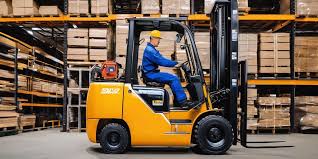Forklifts are the cornerstone of modern industrial operations. From warehouse logistics and shipping yards to manufacturing floors and large-scale construction sites, forklifts are essential for transporting heavy loads quickly and efficiently. However, just like any machine, forklifts require regular upkeep to function reliably—and central to this maintenance is the use of high-quality forklift parts.
When businesses think of forklift maintenance, they often focus on oil changes, brake checks, or battery management. But equally important is the quality and condition of the components that make up these machines. Whether it’s tires, filters, hydraulic systems, or engine components, the right forklift parts are what keep the equipment running safely and efficiently.
In this article, we’ll explore the importance of quality forklift parts, the risks of using inferior or incompatible components, how to source and maintain parts effectively, and why investing in the right parts is one of the smartest decisions an industrial operation can make.
Why Forklift Parts Matter More Than You Think
Forklifts are subjected to intense workloads. They’re often in use across multiple shifts, carrying heavy loads, operating in extreme temperatures, and maneuvering in tight spaces. These conditions cause wear and tear at a faster rate compared to many other types of machinery.
That’s why every component in a forklift must be in optimal condition. A worn-out or faulty part doesn’t just slow down operations—it can jeopardize safety, cause mechanical failure, and lead to unplanned downtime that impacts the bottom line.
Key Roles of High-Quality Forklift Parts:
- Ensure operator and workplace safety
- Maintain load-handling capabilities
- Prevent breakdowns and extend equipment life
- Enhance operational efficiency
- Support compliance with safety standards and regulations
Without dependable parts, even the most robust forklifts can become liabilities rather than assets.
The Most Critical Forklift Parts and Their Functions
Every forklift is a complex machine composed of interdependent systems. Understanding the primary parts and their roles can help you prioritize maintenance and replacement.
1. Forks
These are the most visible and active components. Damaged or bent forks can lead to unstable loads and dangerous conditions. Regular inspection and replacement are essential.
2. Hydraulic System
This system powers the lifting and tilting mechanisms. It includes pumps, hoses, valves, and cylinders. Leaks or damaged components reduce lifting efficiency and create safety risks.
3. Mast and Chains
The mast raises and lowers the forks, while the chains support and stabilize the lift. Both need to be well-lubricated and free of rust or tension issues.
4. Tires
Forklift tires come in pneumatic, solid, or cushion formats. The wrong tire for a surface or worn-down treads can lead to tipping or traction problems.
5. Brakes and Steering
Brakes must respond quickly, especially in high-traffic environments. Worn brake pads or faulty steering parts are among the top causes of warehouse accidents.
6. Engine and Transmission
Whether the forklift runs on gas, diesel, or electricity, its engine and transmission must function seamlessly. This includes fans, belts, filters, spark plugs, and fluid lines.
7. Battery (Electric Forklifts)
Battery maintenance includes not only fluid levels but also connectors, cables, and chargers. Incompatible or failing batteries can damage the entire system.
Using the correct forklift parts for each of these areas is essential for maintaining peak performance and operational reliability.
The Dangers of Using Low-Quality or Incorrect Forklift Parts
It might be tempting to save money by using cheaper or off-brand components. However, this short-term thinking often leads to long-term issues.
1. Equipment Failure
Non-genuine or incompatible parts may not fit properly or handle operational stress, leading to breakdowns during use.
2. Safety Hazards
Faulty brakes, hydraulic leaks, or unstable forks can create immediate danger for operators and nearby personnel.
3. Warranty Issues
Many equipment warranties are voided if unauthorized parts are used during maintenance or repair.
4. Increased Costs Over Time
Cheaper parts tend to wear out faster and require more frequent replacement, leading to higher total costs over the forklift’s life cycle.
5. Operational Delays
Downtime due to part failure can disrupt production schedules, order fulfillment, and customer satisfaction.
Relying on tested and trusted forklift parts helps avoid these pitfalls and ensures smoother operations.
How to Source the Right Forklift Parts for Your Fleet
Getting the correct parts involves more than just matching part numbers. It requires understanding your equipment’s make, model, operating conditions, and load requirements.
Steps to Ensure Proper Sourcing:
1. Know Your Equipment
Keep a detailed inventory of each forklift, including serial numbers, manufacturer specs, and service history.
2. Use OEM or High-Quality Aftermarket Parts
Original Equipment Manufacturer (OEM) parts ensure the best fit and performance. When aftermarket parts are used, choose reputable brands with warranties and proven compatibility.
3. Partner with Reliable Suppliers
Work with vendors who specialize in material handling equipment and can provide expert guidance and fast shipping.
4. Maintain a Parts Inventory
Keeping critical forklift parts in stock—such as filters, belts, or hydraulic hoses—reduces downtime when urgent repairs are needed.
5. Use Digital Parts Management Tools
Modern inventory software can track part usage, alert you to low stock levels, and automate reordering.
Preventive Maintenance and the Role of Parts Replacement
Proactive replacement of worn parts during scheduled maintenance is one of the best strategies for ensuring long-term forklift reliability.
Benefits of Preventive Parts Replacement:
- Minimizes unplanned downtime
- Ensures consistent machine performance
- Reduces the risk of secondary damage
- Improves safety and compliance
Technicians should inspect key components at regular intervals and replace those nearing the end of their service life—even if they haven’t failed yet. This approach supports a proactive maintenance model that keeps fleets running efficiently.
Training and Inspection: Key to Forklift Parts Management
Even the best parts won’t help if they’re installed incorrectly or allowed to fail unnoticed. That’s why training and inspections are critical to a successful parts management strategy.
Operator Training
Teach forklift operators to:
- Perform daily pre-use inspections
- Recognize signs of wear or malfunction
- Report issues promptly to maintenance teams
Technician Training
Ensure your service team can:
- Identify part compatibility and proper installation techniques
- Follow manufacturer specifications
- Use correct torque settings and safety practices during installation
Routine audits and documentation practices also support accountability and continuous improvement.
Technology and the Future of Forklift Parts Management
As the material handling industry evolves, so too does the approach to managing parts. New technologies are streamlining the way businesses monitor and replace forklift parts.
Telematics Integration
Telematics sensors can track part usage and send alerts when specific components show signs of failure or wear.
Predictive Maintenance
AI-driven platforms analyze usage patterns and environmental conditions to predict when parts should be serviced or replaced.
Mobile Inventory Apps
Mobile apps enable warehouse teams to check part availability, reorder, and log usage in real time.
3D Printing and Custom Parts
Emerging technologies like 3D printing offer potential for rapid, on-site production of hard-to-source or discontinued components.
These innovations reduce lead times, improve uptime, and enhance the accuracy of forklift service operations.
Conclusion: Investing in the Right Forklift Parts Pays Off
A forklift is only as reliable as its weakest part. Whether your operation uses a handful of machines or an entire fleet, making smart decisions about forklift parts is essential to long-term success. From safety and performance to compliance and cost control, every component counts.
The most efficient companies understand that forklift parts are not just spare items—they are the heart of an operation’s material handling capabilities. Investing in the right parts, sourced from trusted vendors and maintained by trained professionals, ensures your equipment stays running at full capacity.
By prioritizing quality, consistency, and proactive management, you’re not just maintaining forklifts—you’re powering a more productive, reliable, and future-ready operation.

